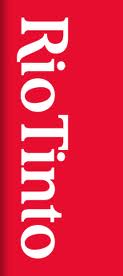 Rio Tinto chief executive Sam Walsh said “We achieved another half of very strong operating performance, powered by productivity gains across our business. Our iron ore expansion continues to deliver high-margin growth reinforcing our position as a low cost producer. It has allowed us to increase shipments of our Pilbara Blend products, providing our customers with reliable, long-term supply of stable quality. Healthy copper volumes reflect higher grades and recoveries at Kennecott Utah Copper, as well as the ramp up at Oyu Tolgoi. With a relentless focus on achieving sustainable cost savings while delivering the highest quality growth, we continue to transform Rio Tinto into a stronger, more disciplined business that will consistently deliver strong cash flows and shareholder value.”
Rio Tinto chief executive Sam Walsh said “We achieved another half of very strong operating performance, powered by productivity gains across our business. Our iron ore expansion continues to deliver high-margin growth reinforcing our position as a low cost producer. It has allowed us to increase shipments of our Pilbara Blend products, providing our customers with reliable, long-term supply of stable quality. Healthy copper volumes reflect higher grades and recoveries at Kennecott Utah Copper, as well as the ramp up at Oyu Tolgoi. With a relentless focus on achieving sustainable cost savings while delivering the highest quality growth, we continue to transform Rio Tinto into a stronger, more disciplined business that will consistently deliver strong cash flows and shareholder value.”
Highlights (Rio Tinto share unless stated otherwise)
|
Q2’14 |
vs Q2’13 |
vs Q1’14 |
H1’14 |
vs H1’13 |
||
| Global iron ore shipments (100% basis) |
mt |
75.7 |
+23% |
+13% |
142.4 |
+20% |
| Global iron ore production (100% basis) |
mt |
73.1 |
+11% |
+10% |
139.5 |
+10% |
| Mined copper |
kt |
164.8 |
+28% |
+4% |
323.0 |
+23% |
| Bauxite |
mt |
10.1 |
-7% |
+1% |
20.2 |
-2% |
| Aluminium |
kt |
839 |
0% |
+1% |
1,671 |
0% |
| Hard coking coal |
mt |
2.0 |
+6% |
+8% |
3.9 |
+9% |
| Semi-soft and thermal coal |
mt |
6.7 |
-7% |
-2% |
13.5 |
+2% |
| Titanium dioxide feedstock |
kt |
372 |
-19% |
-4% |
762 |
-14% |
- Record first half iron ore shipments, production and rail volumes. Shipments from the Pilbara exceeded production as stocks built ahead of the delivery of the expanded infrastructure were drawn down, while existing mines continue to be expanded to utilise increased rail and port capacity.
- In May, Rio Tinto announced that its Pilbara iron ore system of mines, rail and ports reached a run rate of 290 million tonnes a year (Mt/a), two months ahead of schedule.
- The rail duplication and trackwork required for the 360 Mt/a expansion is now complete. Critical 360 Mt/a port infrastructure remains on track for completion by the end of the first half of 2015.
- Full year production guidance for copper has been increased following strong production during the first half, driven by higher grades and concentrator recoveries at Kennecott Utah Copper and the ramp up at Oyu Tolgoi. These led to a 23 per cent increase on a like-for-like basis in the half, and more than offset the impact of divestments in 2013. Sales exceeded production at Oyu Tolgoi in the half as logistics commissioning issues were resolved enabling a strong acceleration in shipments.
- Gove has been operating as a bauxite export business since the curtailment of the refinery in May and is expected to ramp up from current export capacity of 6 Mt/a to 8 Mt/a by the end of 2015. First half global bauxite production was lower than 2013 as the Gove mine adjusted production to reflect the staged curtailment of the alumina refinery during the first half.
- First half aluminium production was in line with last year, with productivity gains across the smelter portfolio offsetting the loss of production from the closure of Shawinigan in November 2013.
- Production of hard coking coal improved in the first half of 2014 following completion of the extension project at the Kestrel mine in the second half of 2013. Thermal coal production set a new first half record, up six per cent on last year.
- Titanium dioxide production was down in the first half as the business continues to match production volumes to underlying demand.
- Exploration and evaluation expenditure was $340 million in the first half of 2014, sustaining the savings achieved in 2013 whilst continuing to progress the highest priority projects.
- The sale of Rio Tinto’s interest in the Clermont thermal coal mine completed on 29 May for cash consideration of $1.015 billion, before adjustments for working capital and net debt.
All currency figures in this report are US dollars, and comments refer to Rio Tinto’s share of production, unless otherwise stated. To allow production numbers to be compared on a like-for-like basis, production from asset divestments completed in 2013 have been excluded.
